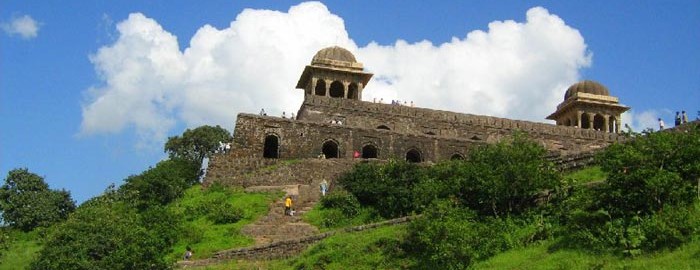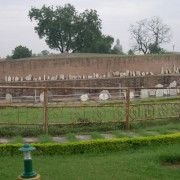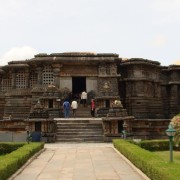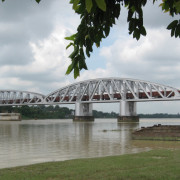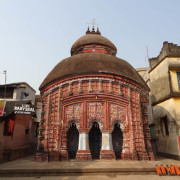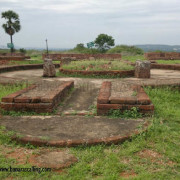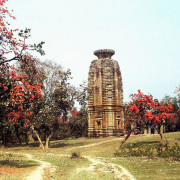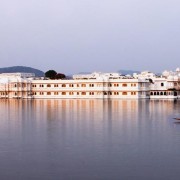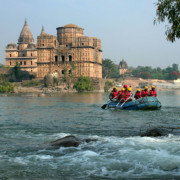Mandu, Madhya Pradesh – Witness of the eternal love story of Rani Roopmati and Baz Bahadur
Perching upon the Vidhya Range at a height of 2000 feet Mandu is a historical destination. The fragrance of the eternal love story of Rani Roopmati and Baz Bahadur still fills up the entire environment. Mandu was previously known as the Shadiabad meaning city of joy. The natural beauty of the place is spectacular. The carpet of green grasses covers the entire area of Mandu. During the monsoon season the natural beauty is at its fullest. Mandu is ideal for a getaway trip.
Places to see at Mandu: Mandu is a historical place with numerous historical sites.
THE DARWAZAS
The 45 km parapets of walls that encircle Mandu are punctuated by 12 gateways. Most notable of these is Delhi Darwaza, the main entrance to the fortress city, for which the approach is through a series of gateways well-fortified with walled enclosures and strengthened by bastions such as the Alamgir and Bhangi Darwaza, through which the present road passes. Rampol Darwaza, Jehangir Gate and Tarapur Gate are some of the other main gateways.
THE ROYAL ENCLAVE
.
Jahaz Mahal
It is a 120 mt long “ship palace” that was built between the two artificial lakes, Munj Talao and Kapur Talao. It is an elegant two storeyed palace. Probably it was built by Sultan Ghiyas-ud-din-Khilji for his large harem. With its open pavilions, balconies overhanging the water and open terrace, Jahaz Mahal are an imaginative recreation in stone of a royal pleasure craft. Viewed on moonlit nights from the adjoining Taveli Mahal, the silhouette of the building, with the tiny domes and turrets of the pavilion gracefully perched on the terrace, presents an unforgettable spectacle.
Hindola Mahal
An audience hall, also belonging to Ghiyas-ud-din’s reign, it derives its name of “swinging palace” from its sloping sidewalls. Superb and innovative techniques are also evident in its ornamental facade, delicate trellis work in sand-stone and beautifully moulded columns. To the West of Hindola Mahal there are several unidentified buildings which still bear traces of their past grandeur. Amidst these is an elaborately constructed well called Champa Baoli which is connected with underground vaulted rooms where arrangements for cold and hot water were made. Other places of interest in this enclave are Dilawar Khan’s Mosque, the Nahar Jharokha (tiger balcony), Taveli Mahal, the two large wells called the Ujali (bright) and Andheri (dark) Baolis and Gada Shah’s Shop and House, all worth a visit.
THE CENTRAL GROUP
Hoshang Shah’s Tomb
This is India’s first marble edifice, and is one of the most prominent examples of Afghan architecture. Its unique features are the magnificently proportioned dome, marble lattice work of remarkable delicacy and the courts and towers consisting of porticoes to mark the four corners of the rectangle. Shah Jahan sent four of his great architects to study the design of and draw inspiration from the Tomb. Among them was Ustad Hamid, who was also associated with the construction of Taj Mahal.
Jami Masjid
Inspired by the great mosque of Damascus, the Jami Masjid was conceived on a grand scale, with a high plinth and a huge domed porch projecting in the centre, the background dominated by similar imposing domes with the intervening space filled up by innumerable domes. One is struck by the huge proportions and the stern simplicity of its construction. The great court of the mosque is enclosed on all sides by huge colonnades with a rich and pleasing variety in the arrangement of arches, pillars, number of bays, and in the rows of domes above.
REWA KUND GROUP
Rewa Kund
A reservoir, built by Baz Bahadur with an aqueduct to provide Roopmati’s palace with water. Today, the pool is revered as a sacred spot.
Baz Bahadur’s Palace
The palace was built by Baz Bahadur in the early 16th century. Its unique features are its spacious courtyards surrounded by halls and high terraces which afford a superb view of the surrounding countryside.
Roopmati’s Pavillion
The pavilion was originally built as an army observation post. From its hilltop perch, this graceful structure with its two pavilions was a retreat of the lovely queen, from where she could see Baz Bahadur’s palace and the Narmada flowing through the Nimar plains far below.
The other monuments include:
Nilkanth
This sacred Shiva shrine is sited in a magnificent setting, at the very edge of a steep gorge. In its tree- shaded courtyard, a sacred pond is fed by a stream, and pilgrims still gather to worship here.
Nilkanth Mahal
Belonging to the Mughal era and close to the Nilkanth shrine, this palace was constructed by the Mughal governor, Shah Badgah Khan for Emperor Akbar’s Hindu wife. On the walls here are some inscriptions of the time of Akbar referring to the futility of earthly pomp and glory. Hathi Mahal, Darya Khan’s Tomb, Dai ka Mahal, Dai ki Chhotti Behan Ka Mahal, Malik Mughit’s Mosque and Jali Mahal are some of the other fascinating monuments. There is also the Echo Point, the ‘Delphic Oracle’ of Mandu. A shout from here reverberates far below and is heard clearly back. The Lohani Caves and Temple Ruins, not far from the royal enclave area also merit a visit due to their association with Mandu’s history and monuments. Sunset Point, in front of the caves affords a panoramic view of the surrounding countryside.
Nearby attractions of Mandu: From Mandu you can make excursion to Dhar fort.
The Dhar Fort is located 35 km away from Mandu. Situated on the hill, on a rectangular hillock this fort is built of red stone. The construction of this strong and imposing fort could become possible due to solid muram and black stone of this hillock. The main entrance of the fort was built to the west.
As mentioned in the diary (Rojnamcha) of Emperor Jehangir this was built by Mohammad Tughlak in 1344 A.D. In 1732 A.D. the rulers of Pawar Dynasty captured the construction plan of the fort suggests that it was built following the injunctions of Samrangan Sutradhar. Kharbuja Mahal and Sheesh Mahal are some of the important buildings in this fort. The Kharbuja Mahal was built in 16th century A.D. This palace is called as Kharbuja Mahal because of its musk melon shape. During the Maratha struggle, Anandi Bai, the wife of Raghunath Rao took shelter here. She gave birth to Peshwa Bajirao II in this palace.
Things to do at Mandu: If you visit during the time of Ganesh Chathurthi you can enjoy the 10 days celebration of the festival there. This is the biggest celebration in Mandu. It’s an interesting blend of Hindu and tribal culture. Besides this enjoy the panoramic beauty of the place along with the historical places.
Best time to visit Mandu: Time to visit Mandu is all through the year and the best during July to March.
How to go ?
By Rail
Mandu does not have a rail station. The nearest station is Indore, at a distance of 64 kms from Mandu.
By Air
The nearest Airport is Devi Ahilya Bai Holkar Airport, Indore, roughly two hour drive from Mandu.
By Road
Mandu is connected with other cities by a good road network. Regular bus services connect Mandu with Dhar (35 km), Indore, Ratlam, Ujjain (154 km) and Bhopal (285 km via Indore).
Where to stay ?
There are plenty of private hotels and lodges available in Mandu. Some options are:
Hotel Royal Palace: +91-099 77 078671, 07292-263336, 07232-263277 Website: www.hotelmandu.com
Malwa Resort: +91-07692-263235, 263221
Note : Phone numbers given above are according to the information available with us. If you find any contact number/s given above is/are incorrect or not in use, please let us know.
.
.

